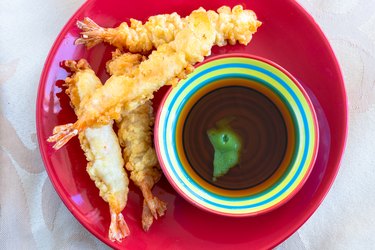
Whether you cook simple flour- or breadcrumb-coated shrimp or make a battered version, deep-fried shrimp is always a crowd pleaser if it's done right. Frying cooked shrimp is easier to do than frying raw, but the secret to success is a perfectly crispy coating.
Obviously, deep-frying isn't the best if you're watching your weight. According to the USDA, a portion of five jumbo tempura shrimp has 314 calories and 17 grams of fat. But shrimp are nutritious: This size serving of fried shrimp also contains 1.4 micrograms (nearly 25 percent of the daily value) of vitamin B12 and 48.3 micrograms (69 percent of the DV) of selenium.
Video of the Day
Video of the Day
Vitamin B12 is needed for a healthy nervous system and red blood cell formation, while selenium is an antioxidant. A November 2015 study in the Journal of Clinical Endocrinology & Metabolism linked low intakes of selenium with sluggish thyroid.
Read more: Is Shrimp Healthy for a Balanced Diet?
Why Use Cooked Shrimp?
Though using raw shrimp is more traditional, frying cooked shrimp has quite a few advantages. For a start, it's simpler, with much less preparation time: There's no fiddly peeling or deveining of the seafood involved, for example. You also don't have to be worried about heating the shrimp to the right internal temperature to ensure food safety. This can definitely take the stress out of frying, as essentially you know the shrimp are good to eat as soon as they look ready.
When you're frying cooked shrimp, you do obviously have to take care as the shrimp can become rubbery and tough quicker. But this is where the crispy coating is a lifesaver — fried shrimp batter helps to retain moisture inside the shrimp, so toughness should not be a problem. This is particularly the case if you cook it at a high temperature, which means the batter will crisp up quickly.
Frying Cooked Shrimp: The Basics
The three most common ways of coating and frying cooked shrimp are buttermilk fried shrimp, breaded shrimp and battered/tempura shrimp. With all these you need to start with shrimp that are fully thawed and patted as dry as possible.
To make buttermilk fried shrimp, dip each shrimp in buttermilk, roll in seasoned flour until well coated, shake off any excess flour and then fry. Traditional southern fried shrimp recipes swap some or all of the flour for cornmeal.
To make breaded shrimp, roll the shrimp first in beaten egg, then in breadcrumbs, before frying. For a drier, crisper result, use Japanese-style Panko breadcrumbs.
For tempura-style shrimp, America's Test Kitchen from KCET TV station says simply whisking this list of ingredients together gives the very best result (these quantities make four servings of fried shrimp batter):
- 1 1/2 cups unbleached all-purpose flour
- 1/2 a cup cornstarch
- 1 large egg
- 1 cup vodka
- 1 cup seltzer water
- Kosher salt to taste
Which Oil to Use?
In an interview with Eater, renowned tempura chef Kiyoshi Chikano from New York's Michelin-starred Tempura Matsui restaurant recommends peanut oil for frying, which he says maintains a very high temperature and makes the food fried in it much crispier.
According to the USDA, peanut oil also has a much higher proportion of unsaturated (mono- and polyunsaturated) fat than saturated fat, which is better for health. Specifically, an American Heart Association review published in the June 2017 issue of Circulation says there are benefits to the heart when saturated fats in the diet are replaced by unsaturated fat.
The recommended cooking temperature for frying cooked shrimp — whether you're talking about buttermilk fried shrimp, breadcrumb-coated shrimp or a tempura-style fried shrimp batter — is 350 degrees Fahrenheit (180 degrees Celsius). Chef Kiyoshi Chikano says making sure your oil stays hot is the secret to ensuring the food won't absorb too much oil, which makes it lighter and healthier too.
- USDA: "Shrimp, Coated, Fried, Made With oil"
- Food and Drug Administration: "Vitamins and Minerals Chart"
- Journal of Clinical Endocrinology and Metabolism: "Low Population Selenium Status Is Associated With Increased Prevalence of Thyroid Disease"
- KCET: "Shrimp Tempura"
- Eater: "Watch: The Only Tempura-Focused Restaurant to Earn a Michelin Star in the U.S."
- USDA: "Peanut Oil"
- Circulation: "Dietary Fats and Cardiovascular Disease: A Presidential Advisory From the American Heart Association"